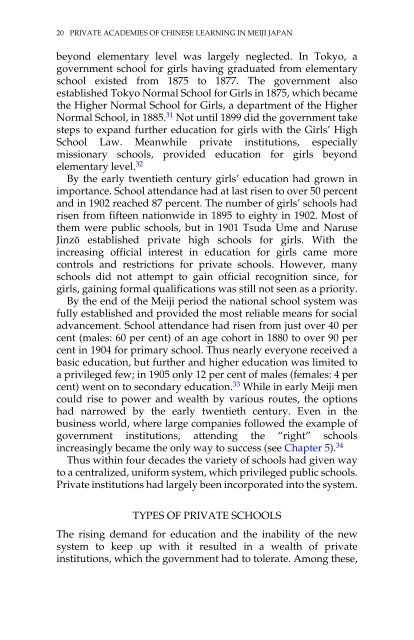Private Academies of Chinese Learning in Meiji Japan: The Decline ...
Private Academies of Chinese Learning in Meiji Japan: The Decline ...
Private Academies of Chinese Learning in Meiji Japan: The Decline ...
Create successful ePaper yourself
Turn your PDF publications into a flip-book with our unique Google optimized e-Paper software.
20 PRIVATE ACADEMIES OF CHINESE LEARNING IN MEIJI JAPANbeyond elementary level was largely neglected. In Tokyo, agovernment school for girls hav<strong>in</strong>g graduated from elementaryschool existed from 1875 to 1877. <strong>The</strong> government alsoestablished Tokyo Normal School for Girls <strong>in</strong> 1875, which becamethe Higher Normal School for Girls, a department <strong>of</strong> the HigherNormal School, <strong>in</strong> 1885. 31 Not until 1899 did the government takesteps to expand further education for girls with the Girls’ HighSchool Law. Meanwhile private <strong>in</strong>stitutions, especiallymissionary schools, provided education for girls beyondelementary level. 32By the early twentieth century girls’ education had grown <strong>in</strong>importance. School attendance had at last risen to over 50 percentand <strong>in</strong> 1902 reached 87 percent. <strong>The</strong> number <strong>of</strong> girls’ schools hadrisen from fifteen nationwide <strong>in</strong> 1895 to eighty <strong>in</strong> 1902. Most <strong>of</strong>them were public schools, but <strong>in</strong> 1901 Tsuda Ume and NaruseJ<strong>in</strong>zō established private high schools for girls. With the<strong>in</strong>creas<strong>in</strong>g <strong>of</strong>ficial <strong>in</strong>terest <strong>in</strong> education for girls came morecontrols and restrictions for private schools. However, manyschools did not attempt to ga<strong>in</strong> <strong>of</strong>ficial recognition s<strong>in</strong>ce, forgirls, ga<strong>in</strong><strong>in</strong>g formal qualifications was still not seen as a priority.By the end <strong>of</strong> the <strong>Meiji</strong> period the national school system wasfully established and provided the most reliable means for socialadvancement. School attendance had risen from just over 40 percent (males: 60 per cent) <strong>of</strong> an age cohort <strong>in</strong> 1880 to over 90 percent <strong>in</strong> 1904 for primary school. Thus nearly everyone received abasic education, but further and higher education was limited toa privileged few; <strong>in</strong> 1905 only 12 per cent <strong>of</strong> males (females: 4 percent) went on to secondary education. 33 While <strong>in</strong> early <strong>Meiji</strong> mencould rise to power and wealth by various routes, the optionshad narrowed by the early twentieth century. Even <strong>in</strong> thebus<strong>in</strong>ess world, where large companies followed the example <strong>of</strong>government <strong>in</strong>stitutions, attend<strong>in</strong>g the “right” schools<strong>in</strong>creas<strong>in</strong>gly became the only way to success (see Chapter 5). 34Thus with<strong>in</strong> four decades the variety <strong>of</strong> schools had given wayto a centralized, uniform system, which privileged public schools.<strong>Private</strong> <strong>in</strong>stitutions had largely been <strong>in</strong>corporated <strong>in</strong>to the system.TYPES OF PRIVATE SCHOOLS<strong>The</strong> ris<strong>in</strong>g demand for education and the <strong>in</strong>ability <strong>of</strong> the newsystem to keep up with it resulted <strong>in</strong> a wealth <strong>of</strong> private<strong>in</strong>stitutions, which the government had to tolerate. Among these,













